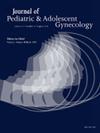20.。两组1型血管性血友病和关节过度活动/ ehers - danlos综合征的青少年和青壮年患者的出血、缺铁和生活质量
IF 1.7
4区 医学
Q3 OBSTETRICS & GYNECOLOGY
引用次数: 0
摘要
1型血管性血友病(VWD)患者会经历大量月经出血(HMB)和其他出血症状,对他们的生活质量产生负面影响。患有广泛性关节活动过度(GJH)和活动过度的埃勒-丹洛斯综合征(hEDS)的个体也会经历HMB和非月经性出血,可能是由于胶原蛋白生成异常。关于HMB在这些人群中的后遗症,包括缺铁,以及对出勤率和行为健康的影响的研究有限。我们的目的是描述HMB,缺铁率,静脉注射铁的需求,以及对1型VWD和GJH/hEDS的青少年和年轻人的出勤率和情绪的影响。方法:我们对2019-2024年在某三级儿童医院妇科/血液学联合诊所就诊的10-25岁HMB患者进行了一项经irb批准的回顾性图表回顾。队列1包括1型VWD患者。队列2包括GJH (Beighton评分≥4)或hEDS(经遗传学家确认)患者。提取的数据包括基线人口统计学、出血评估评分、基线血红蛋白和铁蛋白水平、抑郁或焦虑的存在以及规定的治疗方法。描述性数据用均值和标准差、中位数和极差进行汇总。结果第1组(VWD)纳入111例患者;队列2 (GJH, hEDS)包括26例患者。表1报告了两个队列的基线人口统计数据。两组患者在基线出血评估工具(BAT)和图像失血量评估图(PBAC)上得分都很高(表2)。51%的VWD患者和65%的GJH/hEDS患者报告焦虑和抑郁。54%的VWD和65%的GJH/hEDS需要静脉注射铁。中位总治疗线为2条(VWD)和3条(hEDS)。在通过PBAC和lt定义的出血改善的患者中;100, LNG-IUD(单独或辅助治疗)对GJH/hEDS和VWD的成功率分别为62%和33%。结论GJH/hEDS患者与1型VWD患者表现出相似的出血特征。这些患者尝试几种治疗方法来控制HMB。GHJ/hEDS患者表现出抑郁和焦虑发生率较高的趋势,并且更需要静脉注射铁。我们的研究结果表明,需要提高GJH/hEDS患者的认识和治疗指南。未来的分析将比较两个队列,并评估最有效的治疗方式。本文章由计算机程序翻译,如有差异,请以英文原文为准。
20. Bleeding Profiles, Iron Deficiency, and Quality of Life in Two Cohorts of Adolescents and Young Adults with Type 1 Von Willebrand Disease and Joint Hypermobility/Ehlers-Danlos Syndrome
Background
Patients with Type 1 Von Willebrand Disease (VWD) experience heavy menstrual bleeding (HMB) and other bleeding symptoms that negatively impact their quality of life. Individuals with Generalized Joint Hypermobility (GJH) and hypermobile Ehlers-Danlos Syndrome (hEDS) also experience HMB and non-menstrual bleeding, likely due to abnormalities of collagen production. Limited research exists regarding the sequelae of HMB among these populations, including iron deficiency, and impact on school attendance and behavioral health. We aim to describe HMB, rates of iron deficiency, need for intravenous iron, and impact on school attendance and mood in adolescents and young adults with Type 1 VWD and GJH/hEDS.
Methods
We performed an IRB-approved, retrospective chart review of patients aged 10-25, presenting with HMB to a combined gynecology/hematology clinic at a tertiary children's hospital from 2019-2024. Cohort 1 included patients with Type 1 VWD. Cohort 2 included patients with GJH (Beighton score ≥ 4) or hEDS (confirmed by a geneticist). Extracted data included baseline demographics, bleeding assessment scores, baseline hemoglobin and ferritin levels, presence of depression or anxiety, and treatments prescribed. Descriptive data are summarized using mean and standard deviation, median and ranges.
Results
Cohort 1 (VWD) included 111 patients; Cohort 2 (GJH, hEDS) included 26 patients. Table 1 reports baseline demographics in both cohorts. Patients in both cohorts had high scores on baseline Bleeding Assessment Tool (BAT) and pictorial blood loss assessment chart (PBAC) (Table 2). Anxiety and depression were reported by 51% of individuals with VWD and 65% GJH/hEDS patients. Intravenous iron was needed for 54% VWD and 65% GJH/hEDS. Median total lines of treatment were 2 (VWD) and 3 (hEDS). Among patients who achieved bleeding improvement, defined by PBAC < 100, the LNG-IUD (alone or with supplemental therapy) was successful for 62% GJH/hEDS and 33% VWD.
Conclusions
Patients with GJH/hEDS and Type 1 VWD demonstrate similar bleeding profiles. These patients attempt several lines of therapy to control HMB. Patients with GHJ/hEDS demonstrate a trend towards higher rates of depression and anxiety and a greater need for intravenous iron. Our results suggest greater awareness and treatment guidelines are needed for patients with GJH/hEDS. Future analyses will compare the two cohorts and will assess the most effective treatment modalities.
求助全文
通过发布文献求助,成功后即可免费获取论文全文。
去求助
来源期刊
CiteScore
3.90
自引率
11.10%
发文量
251
审稿时长
57 days
期刊介绍:
Journal of Pediatric and Adolescent Gynecology includes all aspects of clinical and basic science research in pediatric and adolescent gynecology. The Journal draws on expertise from a variety of disciplines including pediatrics, obstetrics and gynecology, reproduction and gynecology, reproductive and pediatric endocrinology, genetics, and molecular biology.
The Journal of Pediatric and Adolescent Gynecology features original studies, review articles, book and literature reviews, letters to the editor, and communications in brief. It is an essential resource for the libraries of OB/GYN specialists, as well as pediatricians and primary care physicians.

 求助内容:
求助内容: 应助结果提醒方式:
应助结果提醒方式:


